Performances Analysis of Three Grid-Tied Large-Scale Solar PV Plants in Varied Climatic Conditions: A Case Study in Algeria
Abstract
:1. Introduction
- An analysis of the performances of three (3) solar photovoltaic plants including Sidi-bel-Abbés (12 MWp), Laghouat, (60 MWp), and Ghardaïa (1.1 MWp) located in different regions covering different climatic conditions in Algeria.
- The prediction of the relationship between key factors such as the alternative power output “PAC” and ratio performance of three (3) solar photovoltaic plants using module temperature, air temperature, and solar irradiance, based on statistical analysis.
- A comparison study of the performances of the three studied solar photovoltaic plants with other plants installed across the world.
2. Materials and Methods
2.1. Description of Three Power Plants
2.2. Performances Analysis of the Three Solar Photovoltaic Plants (SPVP)
2.2.1. Global Radiation and Alternative Energy Output EAC
2.2.2. Reference Yield Factor “Yr”
2.2.3. Final Yield Factor “Yf”
2.2.4. Performance Ratio “PR”
2.2.5. Capacity Factor “CF”
3. Results and Discussions
3.1. Yield Factors
3.2. Performance Ratio and Capacity Factor
3.3. Classification of Photovoltaic Power Plants in Algeria
3.4. Comparison of the Three PV Plants with Other PV Plants around the World
4. Statistical Analysis and Comparison
5. Conclusions
- The yearly average daily reference yield for the three PV plants was 5.01 kWh/kWp/d, 5.3 kWh/kWp/d, and 6.51 kWh/kWp/d, respectively. Meanwhile, the yearly average air temperatures recorded were 15.5 °C, 21.75 °C, and 29.04 °C, respectively. Based on these values, the average daily final yield “Yf” was found to be 4.15 kWh/kWp/d, 4.68 kWh/kWp/d, and 4.94 kWh/kWp/d for the three plants.
- The annual average performance ratio “PR” for the three photovoltaic plants was 0.8301, 0.883, and 0.759, respectively. The average capacity factor “CF” values were 17.20%, 19.45%, and 20.6% for SPVP_1, SPVP_2, and SPVP_3, respectively. These results help researchers in the field of solar photovoltaic energy to carry out comparative studies for the design and selection of the best technology related to the concerned location. The results also indicate that SPVP_2 exhibits the highest performance compared to both SPVP_1 and SPVP_3, as well as other PV systems installed at different locations in Algeria, as shown in Table 2. The comparison resulting from the present study proved clearly that the performance of a power PV plant is not only dependent on the solar irradiance but also dependent on the outdoor conditions, which affect significantly the power PV plant performance.
- Statistical analysis revealed linear models correlating the AC output power (PAC) with solar irradiance and the PV module temperature, as well as the performance ratio with air temperature. These models enable the accurate prediction of the AC output power for the three power plants.
Author Contributions
Funding
Institutional Review Board Statement
Informed Consent Statement
Data Availability Statement
Acknowledgments
Conflicts of Interest
References
- Program for Renewable Energy and Energy Efficiency; Ministry of Energy and Mines of Algeria: Algiers, Algeria, 2011. Available online: https://www.energy.gov.dz/ (accessed on 20 January 2023).
- Abada, Z.; Bouharkat, M. Study of management strategy of energy resources in Algeria. Energy Rep. 2018, 4, 1–7. [Google Scholar] [CrossRef]
- Bouraiou, A.; Hamouda, M.; Chaker, A.; Lachtar, S.; Neçaibia, A.; Boutasseta, N.; Mostefaoui, M. Experimental evaluation of the performance and degradation of single crystalline silicon photovoltaic modules in the Saharan environment. Energy 2017, 132, 22–30. [Google Scholar] [CrossRef]
- Dabou, R.; Bouchafaa, F.; Arab, A.H.; Bouraiou, A.; Draou, M.D.; Neçaibia, A.; Mostefaoui, M. Monitoring and performance analysis of grid connected photovoltaic under different climatic conditions in south Algeria. Energy Convers. Manag. 2016, 130, 200–206. [Google Scholar] [CrossRef]
- Boudghene Stambouli, A. Algerian renewable energy assessment: The challenge of sustainability. Energy Policy 2011, 39, 4507–4519. [Google Scholar] [CrossRef]
- Zaghba, L.; Khennane, M.; Fezzani, A.; Borni, A.; Hadj Mahammed, I. Experimental outdoor performance evaluation of photovoltaic plant in a Sahara environment (Algerian desert). Int. J. Ambient. Energy 2022, 43, 314–324. [Google Scholar] [CrossRef]
- Prime Minister of Algeria. Plan d’action du Gouvernement 16-02-2020. 2020. Available online: http://www.premier-ministre.gov.dz/fr/documents/textes-de-references/plans-d-actions (accessed on 20 January 2023).
- Ministère de l’Energie (ME). Energies Nouvelles, Renouvelables et Maitrise de l’Energie. Available online: https://www.energy.gov.dz/?rubrique=energies-nouvelles-renouvelables-et-maitrise-e-lrenergie (accessed on 20 January 2023).
- Hassan, Q.; Jaszczur, M.; Przenzak, E.; Abdulateef, J. The PV cell temperature effect on the energy production and module efficiency. In Proceedings of the Contemporary Problems of Power Engineering and Environmental Protection, Gliwice, Poland; 2016; Volume 33, p. 1. [Google Scholar]
- Kazem, H.A.; Al-Badi, H.A.; Al Busaidi, A.S.; Chaichan, M.T. Optimum design and evaluation of hybrid solar/wind/diesel power system for Masirah Island. Environ. Dev. Sustain. 2017, 19, 1761–1778. [Google Scholar] [CrossRef]
- Fezzani, A.; Hadj-Mahammed, I.; Kouzou, A.; Zaghba, L.; Drid, S.; Khennane, M.; Kennel, R.; Abdelrahem, M. Energy Efficiency of Multi-Technology PV Modules under Real Outdoor Conditions—An Experimental Assessment in Ghardaïa, Algeria. Sustainability 2022, 14, 1771. [Google Scholar] [CrossRef]
- Naji Alhsnawi, B.; Jasim, B.H. A New energy management system of On-grid/Off–grid using adaptive Neuro-Fuzzy inference system. J. Eng. Sci. Technol. 2020, 15, 3903–3919. [Google Scholar]
- Okonkwo, P.C.; Barhoumi, E.; Murugan, S.; Zghaibeh, M.; Otor, C.; Abo-Khalil, A.G.; Amer Mohamed, A.M. Economic analysis of cross-breed power arrangement for Salalah region in the Al-Khareef season. Int. J. Sustain. Energy 2020, 40, 188–206. [Google Scholar] [CrossRef]
- Okonkwo, P.C.; Barhoumi, E.; Emori, W.; Issa Shammas, M.; Uzoma, P.C.; Amer Mohamed, A.M.; Abdullah, A.M. Economic evaluation of hybrid electrical systems for rural electrification: A case study of a rural community in Nigeria. Int. J. Green Energy 2022, 19, 1059–1071. [Google Scholar] [CrossRef]
- Med Yahya, A.; Mahmoud, A.K.; Daher, D.H.; Gaillard, L.; Menezo, C.; Youm, I.; Mellit, A. Performance analysis of a 48kWp grid-connected photovoltaic plant in the Sahelian climate conditions of Nouakchott, Mauritania. Preprints 2021, 2021020275. [Google Scholar] [CrossRef]
- Attari, K.; Elyaakoubi, A.; Asselman, A. Performance analysis and investigation of a grid-connected photovoltaic installation in Morocco. Energy Rep. 2016, 2, 261–266. [Google Scholar] [CrossRef]
- Kazem, H.A.; Khatib, T.; Sopian, K.; Elmenreich, W. Performance and feasibility assessment of a 1.4 kW roof top grid-connected photovoltaic power system under desertic weather conditions. Energy Build. 2014, 82, 123–129. [Google Scholar] [CrossRef]
- Emziane, M.; Al Ali, M. Performance assessment of rooftop PV systems in Abu Dhabi. Energy Build. 2015, 108, 101–105. [Google Scholar] [CrossRef]
- Cubukcu, M.; Gumus, H. Performance Analysis of a Grid-Connected Photovoltaic Plant in Eastern Turkey. Sustain. Energy Technol. Assess. 2020, 39, 100724. [Google Scholar] [CrossRef]
- Kumar, N.M.; Yadav, S.K.; Chopra, S.S.; Bajpai, U.; Gupta, R.P.; Padmanaban, S.; Blaabjerg, F. Operational performance of on-grid solar photovoltaic system integrated into pre-fabricated portable cabin buildings in warm and temperate climates. Energy Sustain. Dev. 2020, 57, 109–118. [Google Scholar] [CrossRef]
- Kymakis, E.; Kalykakis, S.; Papazoglou, T.M. Performance Analysis of a Grid Connected Photovoltaic Park on the Island of Crete. Energy Convers. Manag. 2009, 50, 433–438. [Google Scholar] [CrossRef]
- Cherfa, F.; Hadj Arab, A.; Oussaid, R.; Abdeladim, K.; Bouchakour, S. Performance analysis of the mini-grid connected photovoltaic system at Algiers. Energy Procedia 2015, 83, 226–236. [Google Scholar] [CrossRef]
- Kichene, M.; Boudghene Stambouli, A.; Chouder, A.; Loukriz, A.; Bendib, A.; Hafiz, A. Performance Investigation of a Large-Scale Grid-Tied PV Plant under High Plateau Climate Conditions: Case Study Ain El-Melh, Algeria. J. Eur. Des Systèmes Autom. 2023, 56, 483–492. [Google Scholar] [CrossRef]
- Ihaddadene, R.; Elhassen Jed, M.; Ihaddadene, N.; De Souza, A. Analytical assessment of Ain Skhouna PV plant performance connected to the grid under a semi-arid climate in Algeria. Sol. Energy 2022, 232, 52–62. [Google Scholar] [CrossRef]
- El-Hadi Dahmoun, M.; Bekkouche, B.; Sudhakar, K.; Guezgouz, M.; Chenafi, A.; Chaouch, A. Performance evaluation and analysis of grid-tied large scale PV plant in Algeria. J. Renew. Sustain. Energy 2021, 224, 279–284. [Google Scholar] [CrossRef]
- Sahouane, N.; Dabou, R.; Ziane, A.; Necaibia, A.; Bouraiou, A.; Rouabhia, A.; Mohammed, B. Energy and economic efficiency performance assessment of a 28 kWp photovoltaic grid-connected system under desertic weather conditions in Algerian Sahara. Renew. Energy 2019, 143, 1318–1330. [Google Scholar] [CrossRef]
- Dahbi, H.; Aoun, N.; Sellam, M. Performance analysis and investigation of a 6 MW grid-connected ground-based PV plant installed in hot desert climate conditions. Int. J. Energy Environ. Eng. 2021, 12, 577–587. [Google Scholar] [CrossRef]
- Bentouba, S.; Bourouis, M.; Zioui, N.; Pirashanthan, A.; Velauthapillai, D. Performance assessment of a 20MWphotovoltaic power plant in a hot climate using real data and simulation tools. Energy Rep. 2021, 7, 7297–7314. [Google Scholar] [CrossRef]
- Chikha, M.; Berkane, S.; Mahrane, A.; Sellami, R.; Yassaa, N. Performance assessment of a 400 kWp multi- technology photovoltaic grid-connected pilot plant in arid region of Algeria. Renew. Energy 2021, 172, 488–501. [Google Scholar] [CrossRef]
- BS EN 61724:1998; Photovoltaic System Performance Monitoring-Guidelines for Measurement, Data Exchange and Analysis. Technical Committee GEL/82; B.E. British Standards Institution: London, UK, 1998.
- Marion, B.; Adelstein, J.; Boyle, K.; Hayden, H.; Hammond, B.; Fletcher, T.; Canada, B.; Narang, D.; Shugar, D.; Wenger, H.; et al. Performance Parameters for grid-connected PV systems. Energy Rep. 2005, 3, 76–84. [Google Scholar]
- Ayompe, L.M.; Duffy, A.; Mccormack, S.J.; Conlon, M. Measured performance of a 1.72 kW rooftop grid connected photovoltaic system in Ireland. Energy Convers. Manag. 2011, 52, 816–825. [Google Scholar] [CrossRef]
- Sreenath, S.; Sudhakar, K.; Yusop, A.F.; Solomin, E.; Kirpichnikova, I.M. Solar PV energy system in Malaysian airport: Glare analysis, general design and performance assessment. Energy Rep. 2020, 6, 698–712. [Google Scholar] [CrossRef]
- Moore, L.M.; Post, H.N. Five years of operating experience at a large. Utility scale photovoltaic generating plant. Prog. Photovolt. Res. Appl. 2008, 16, 249–259. [Google Scholar] [CrossRef]
- Aoun, N.; Bouchouicha, K.; Chenni, R. Performance evaluation of a mono-crystalline photovoltaic module under different weather and sky conditions. Int. J. Renew. Energy Res. 2017, 7, 292–297. [Google Scholar]
- Allouhi, A.; Saadani, R.; Buker, M.S.; Kousksou, T.; Jamil, A.; Rahmoune, M. Energetic, economic and environmental (3E) analyses and LCOE estimation of three technologies of PV grid-connected systems under different climates. Sol. Energy 2019, 178, 25–36. [Google Scholar] [CrossRef]
- Sukumaran, S.; Sudhakar, K. Fully solar powered Raja Bhoj International Airport: A feasibility study. Resour.-Eff. Technol. 2017, 3, 309–316. [Google Scholar] [CrossRef]
- Bhola, P.; Bhardwaj, S. Clustering-based computation of degradation rate for photovoltaic systems. J. Renew. Sustain. Energy 2019, 11, 014701. [Google Scholar] [CrossRef]
- Saleheen, M.Z.; Salema, A.A.; Mominul Islam, S.M.; Sarimuthu, C.R.; Hasan, M.Z. A target-oriented performance assessment and model development of a grid-connected solar PV (GCPV) system for a commercial building in Malaysia. Renew. Energy 2021, 171, 371–382. [Google Scholar] [CrossRef]
- Vasisht, M.; Shravanth Srinivasan, J.; Ramasesha Sheela, K. Performance of solar photovoltaic installations: Effect of seasonal variations. Sol. Energy 2016, 131, 39–46. [Google Scholar] [CrossRef]
- Yadav, S.K.; Bajpai, U. Performance evaluation of a rooftop solar photovoltaic power plant in Northern India. Energy Sustain. Dev. 2018, 43, 130–138. [Google Scholar] [CrossRef]
- Kumar, M.N.; Sudhakar, K.; Samykano, M. Performance comparison of BAPV and BIPV systems with c-Si, CIS and CdTe photovoltaic technologies under tropical weather conditions. Case Stud. Therm. Eng. 2019, 13, 100374. [Google Scholar] [CrossRef]
- Zhang, W.; Zheng, Z.; Liu, H. Droop control method to achieve maximum power output of photovoltaic for parallel inverter system. CSEE J. Power Energy Syst. 2022, 8, 1636–1645. [Google Scholar] [CrossRef]
- Malvoni, M.; Leggieri, A.; Maggiotto, G.; Congedo, P.M.; De Giorgi, M.G. Long Term Performance, Losses and Efficiency Analysis of a 960 kWp Photovoltaic System in the Mediterranean Climate. Energy Convers. Manag. 2017, 145, 169–181. [Google Scholar] [CrossRef]
- Adaramola, M.S.; Vågnes, E.E.T. Preliminary assessment of a small-scale rooftop PV-grid tied in Norwegian climatic conditions. Energy Convers. Manag. 2015, 90, 458–465. [Google Scholar] [CrossRef]
- De Lima, L.C.; de Araújo Ferreira, L.; de Lima Morais, F.H.B. Performance analysis of a grid connected photovoltaic system in North-Eastern Brazil. Energy Sustain. Dev. 2017, 37, 79–85. [Google Scholar] [CrossRef]
- Huang, N.; Zhao, X.; Guo, Y.; Cai, G.; Wang, R. Distribution network expansion planning considering a distributed hydrogen-thermal storage system based on photovoltaic development of the Whole County of China. Energy 2023, 278, 127761. [Google Scholar] [CrossRef]
- Ban, Y.; Liu, X.; Yin, Z.; Li, X.; Yin, L.; Zheng, W. Effect of urbanization on aerosol optical depth over Beijing: Land use and surface temperature analysis. Urban Clim. 2023, 51, 101655. [Google Scholar] [CrossRef]
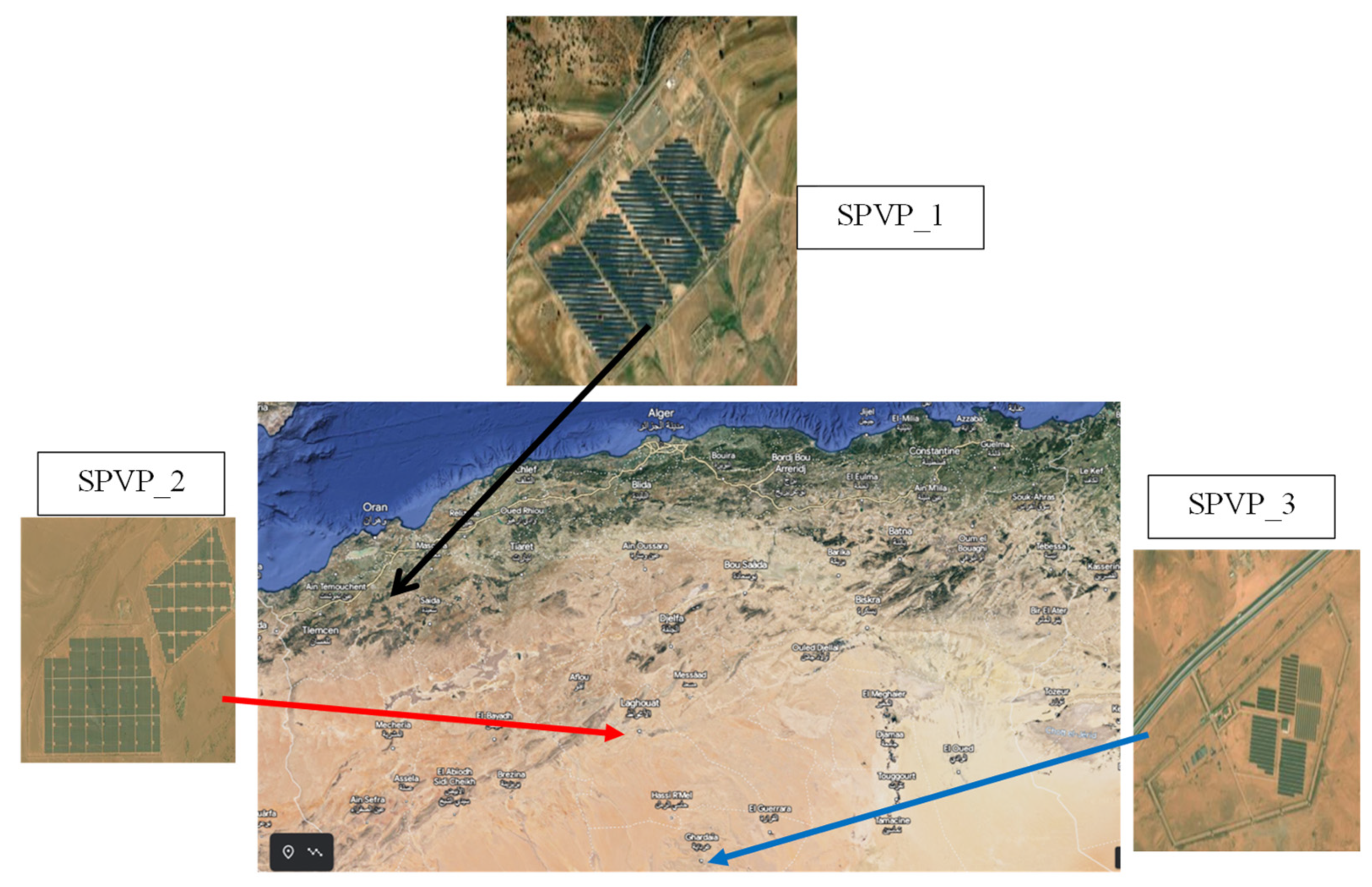
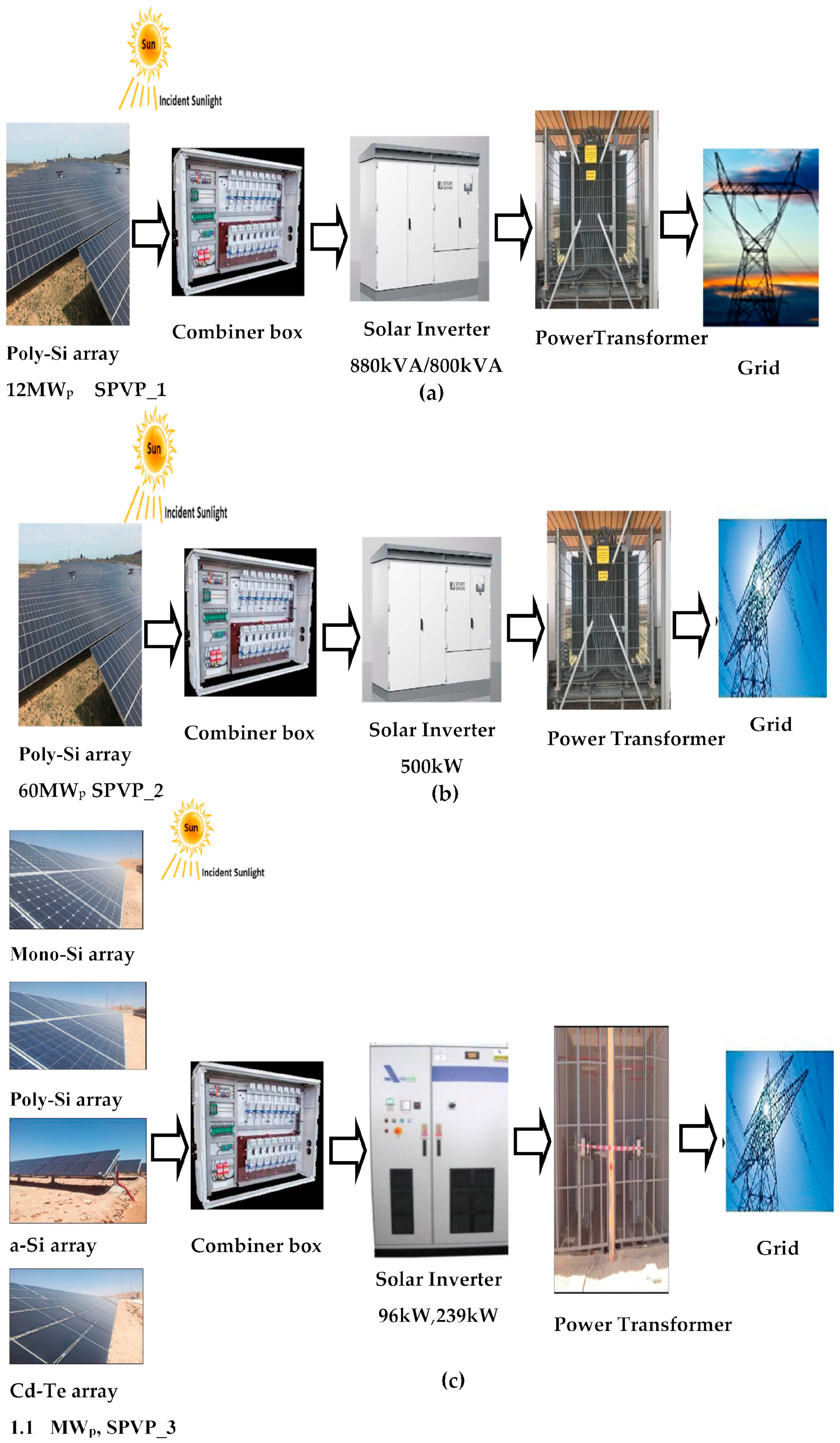
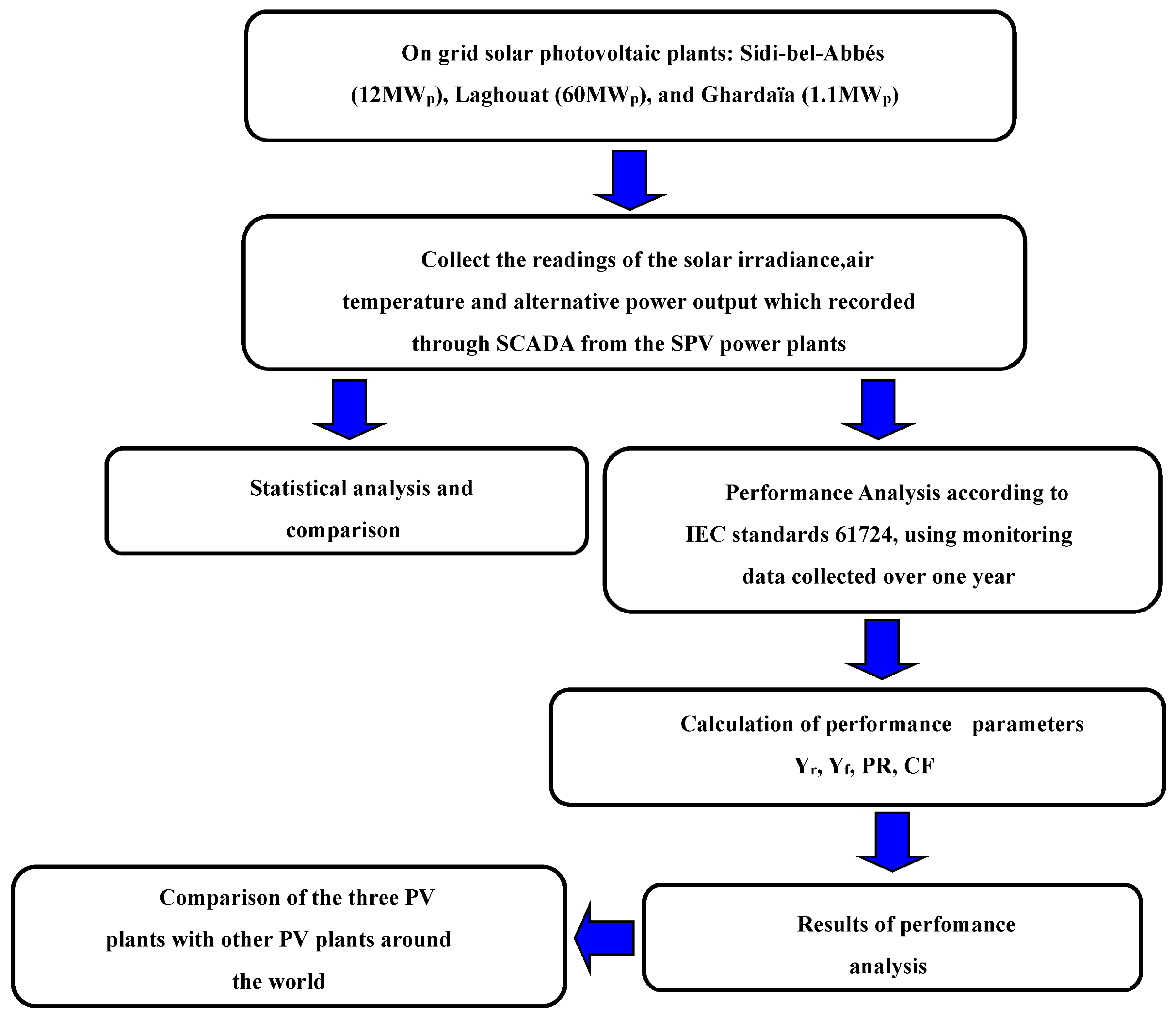
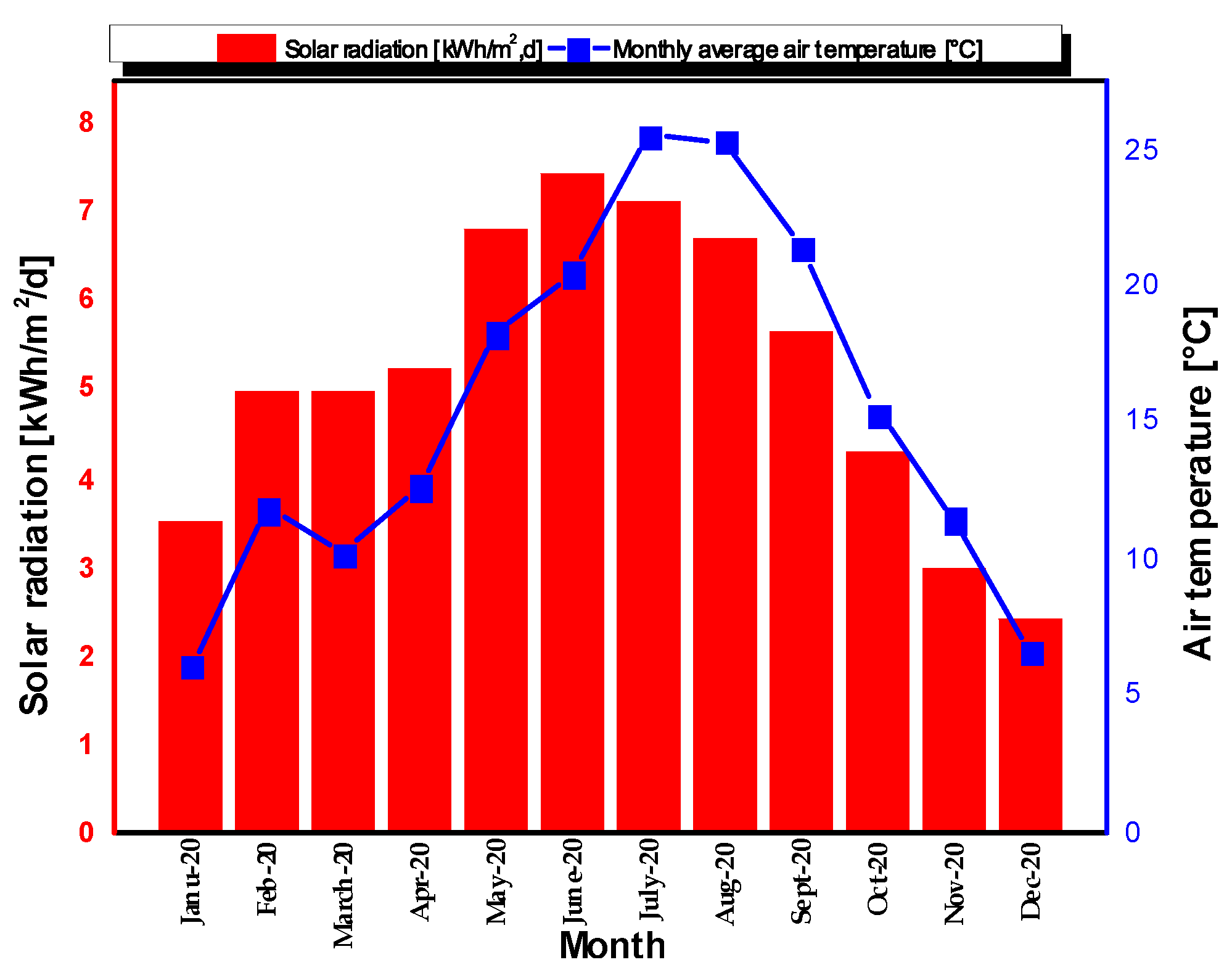
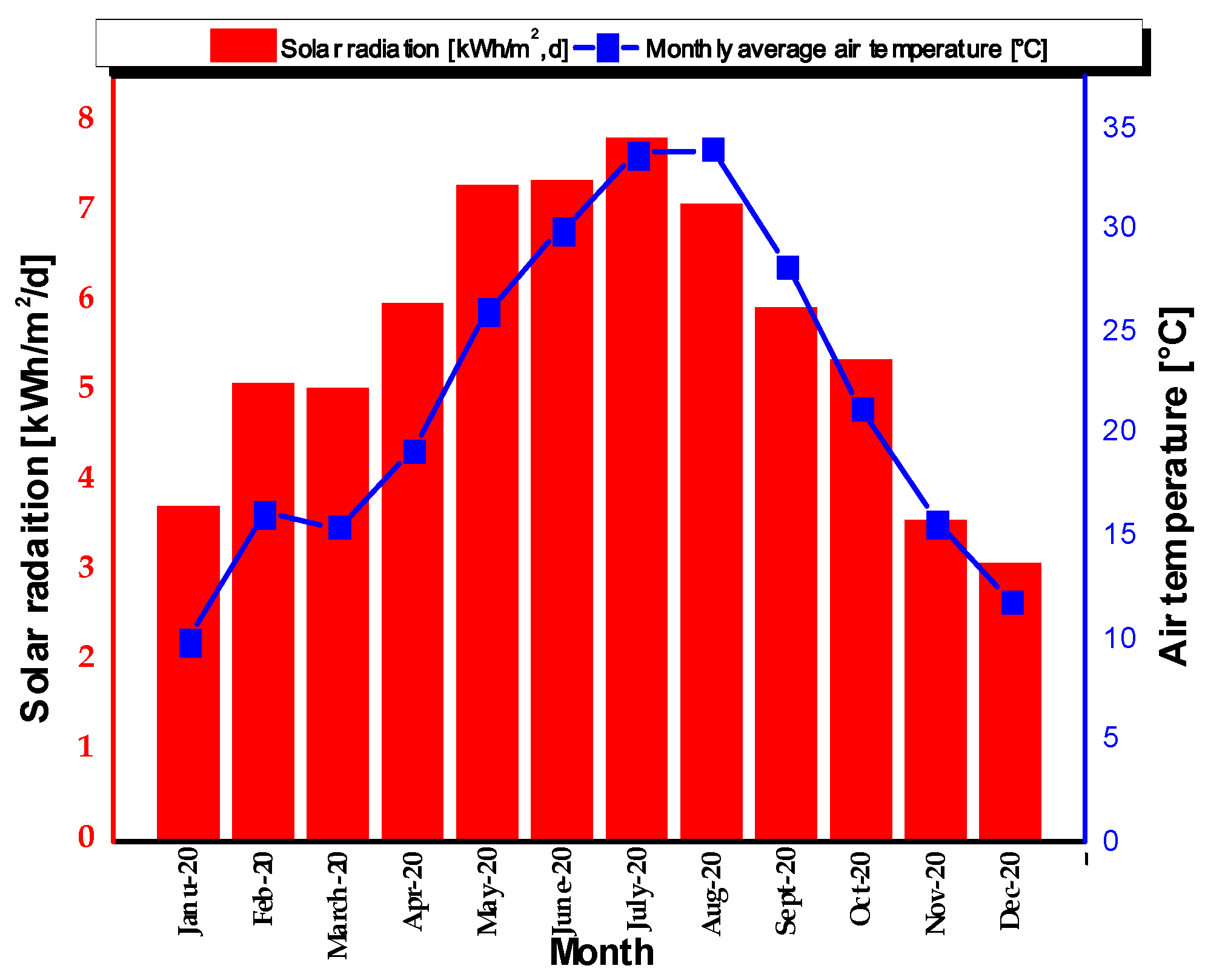
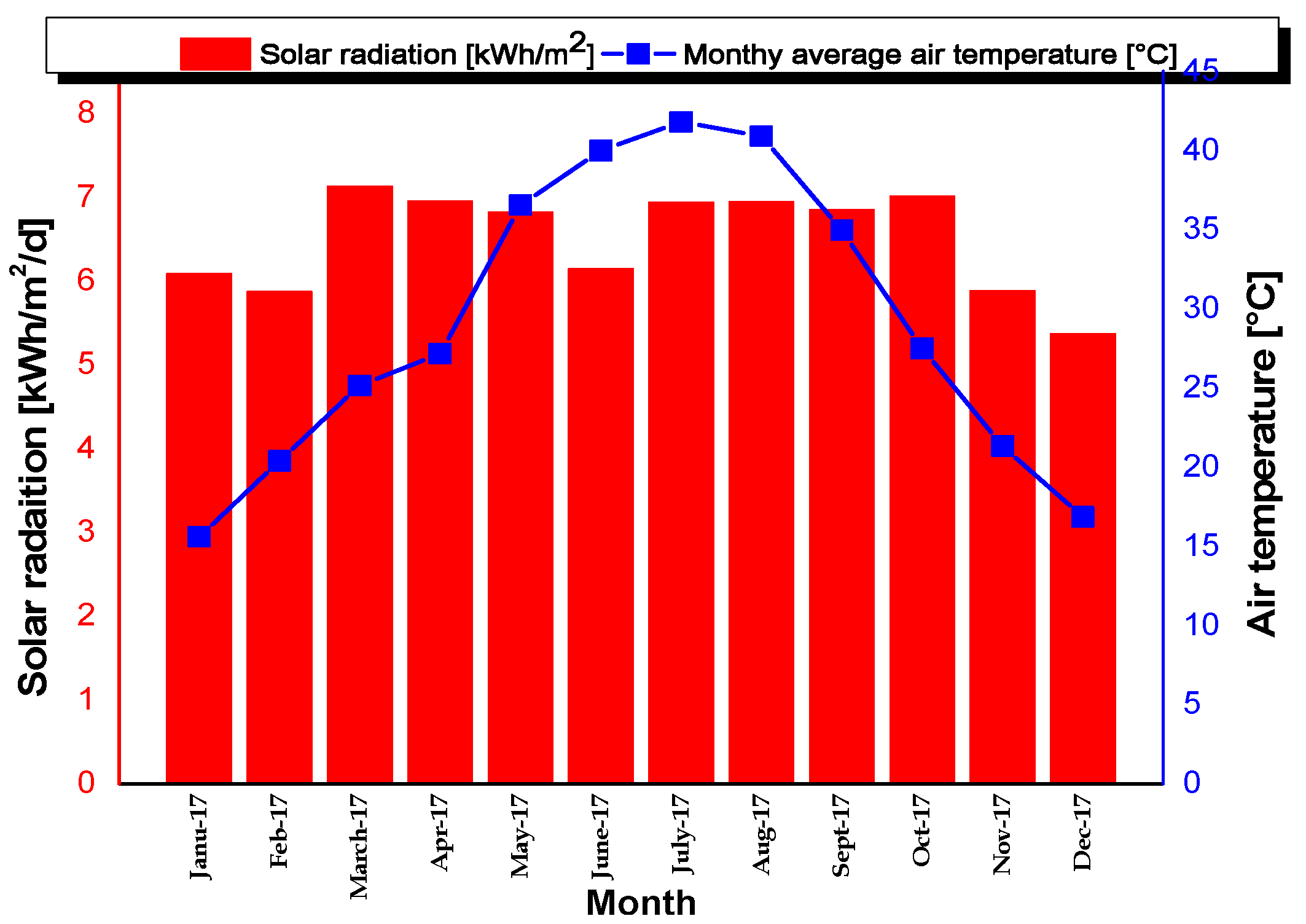
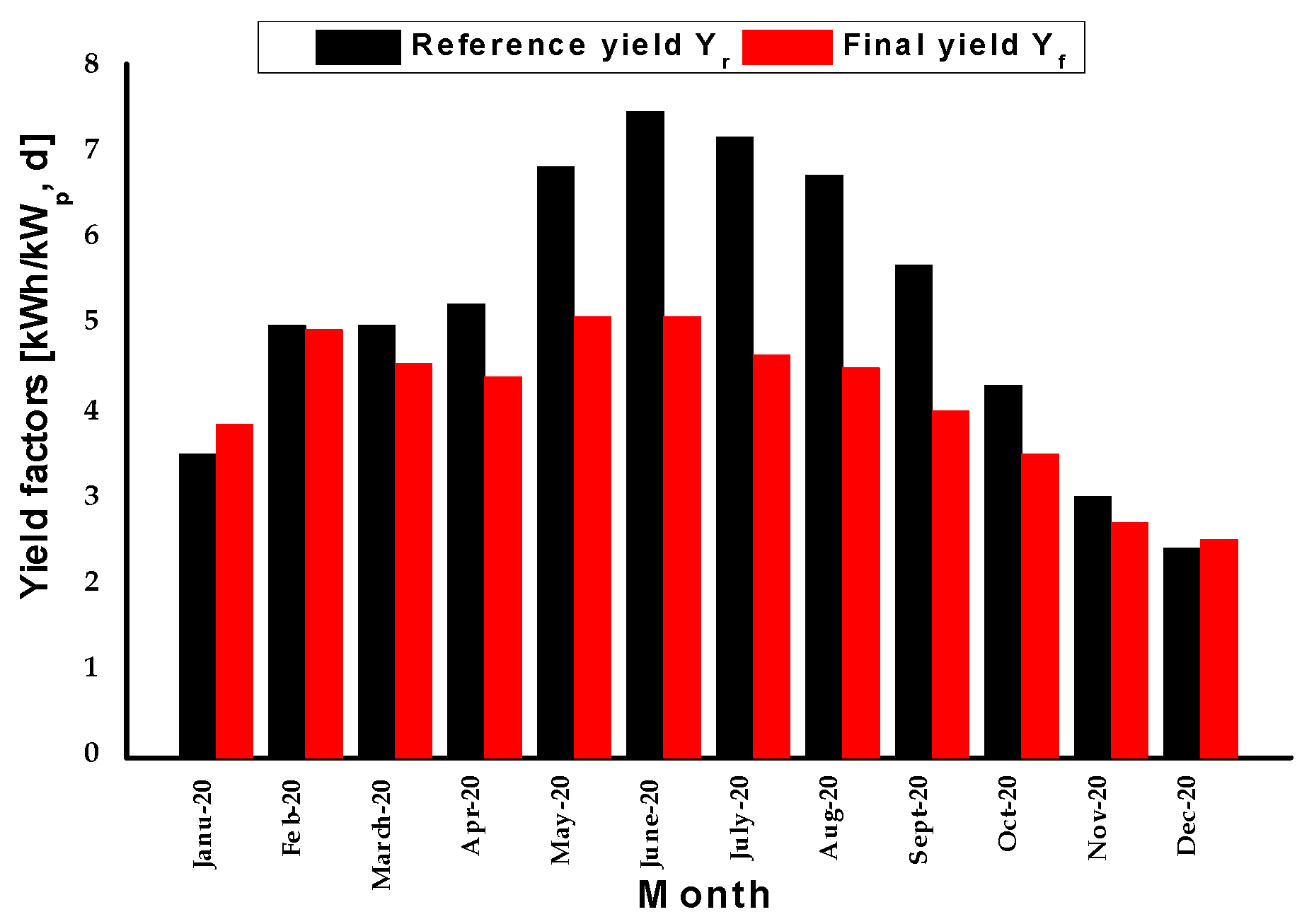

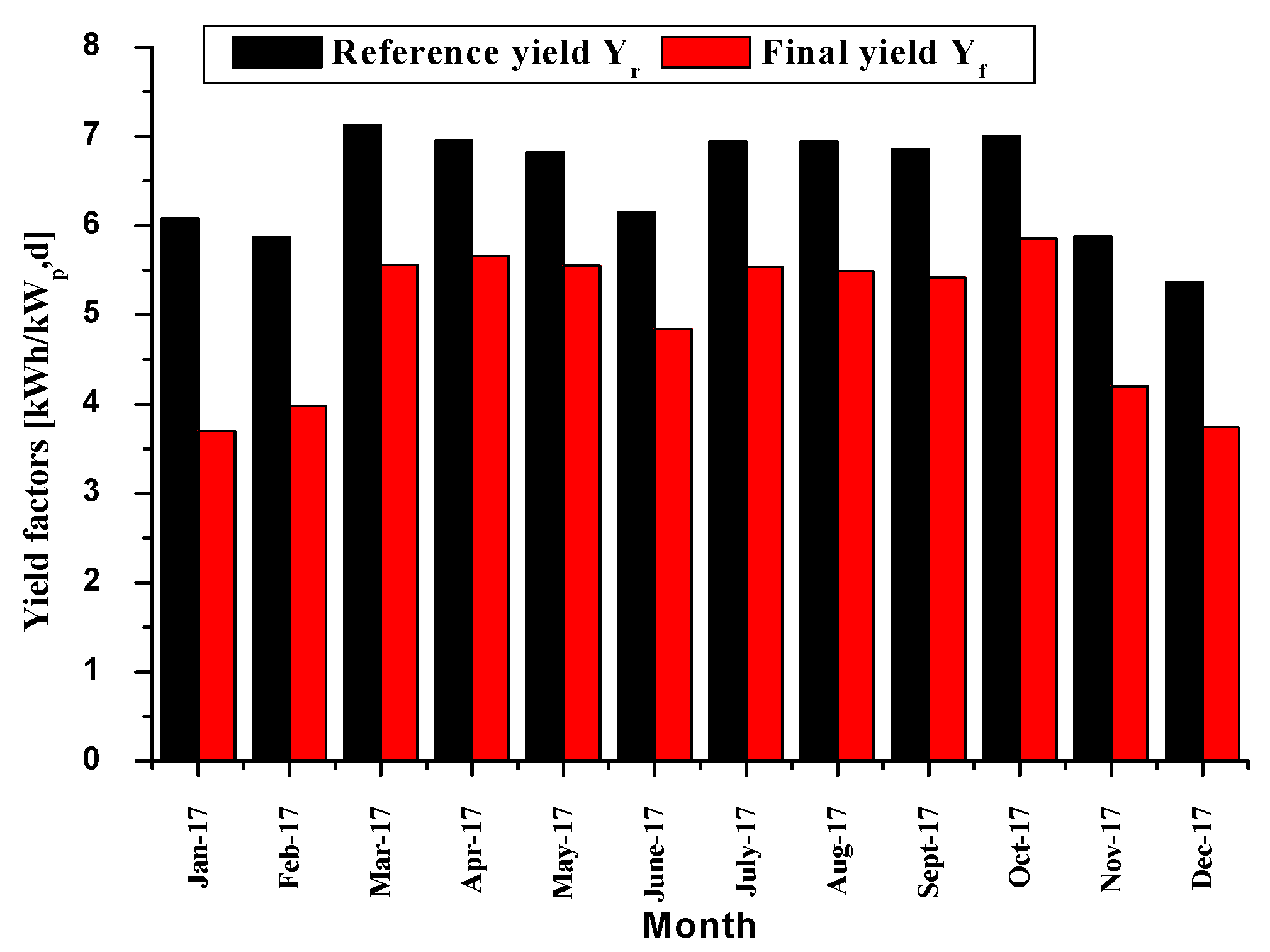
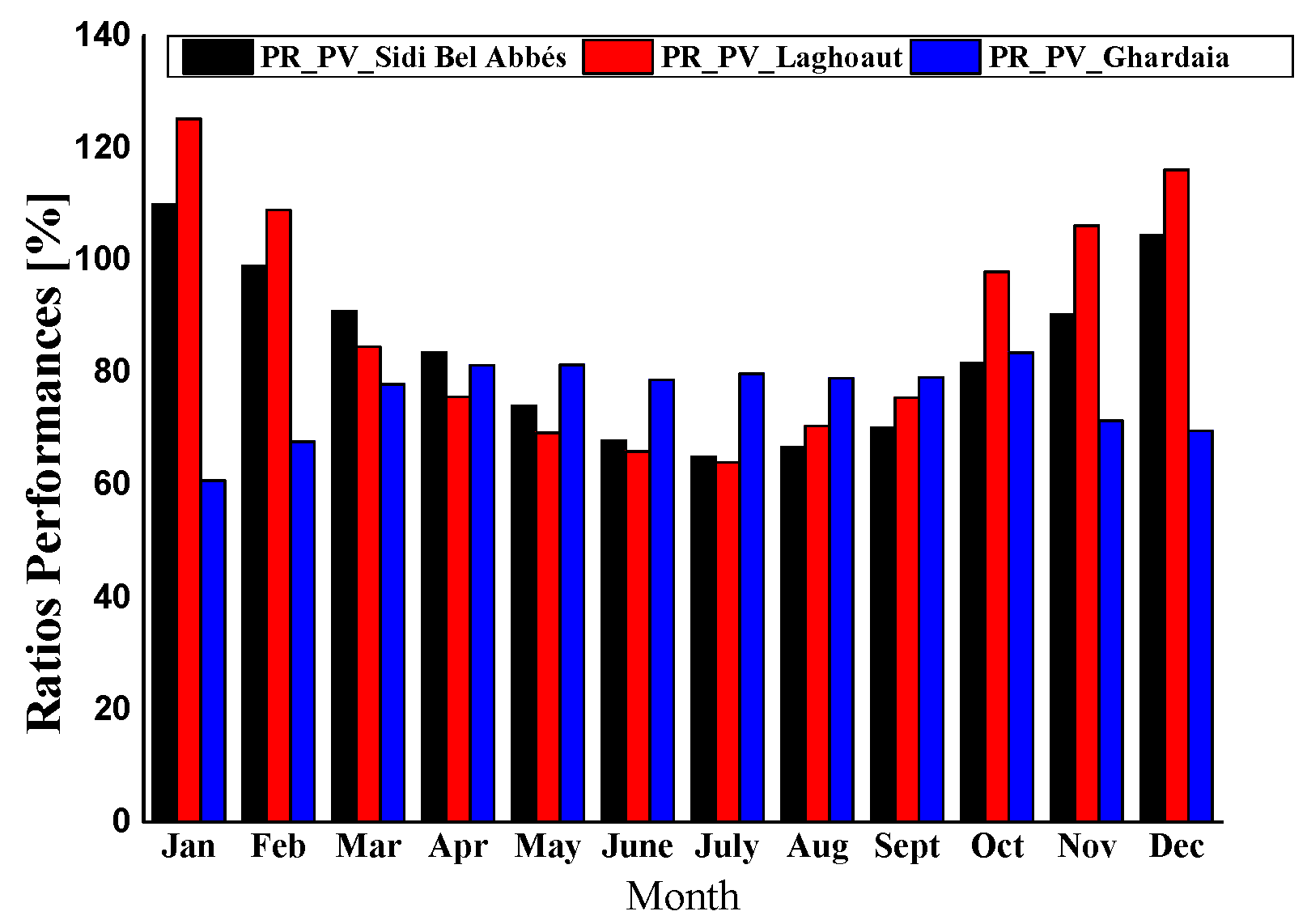
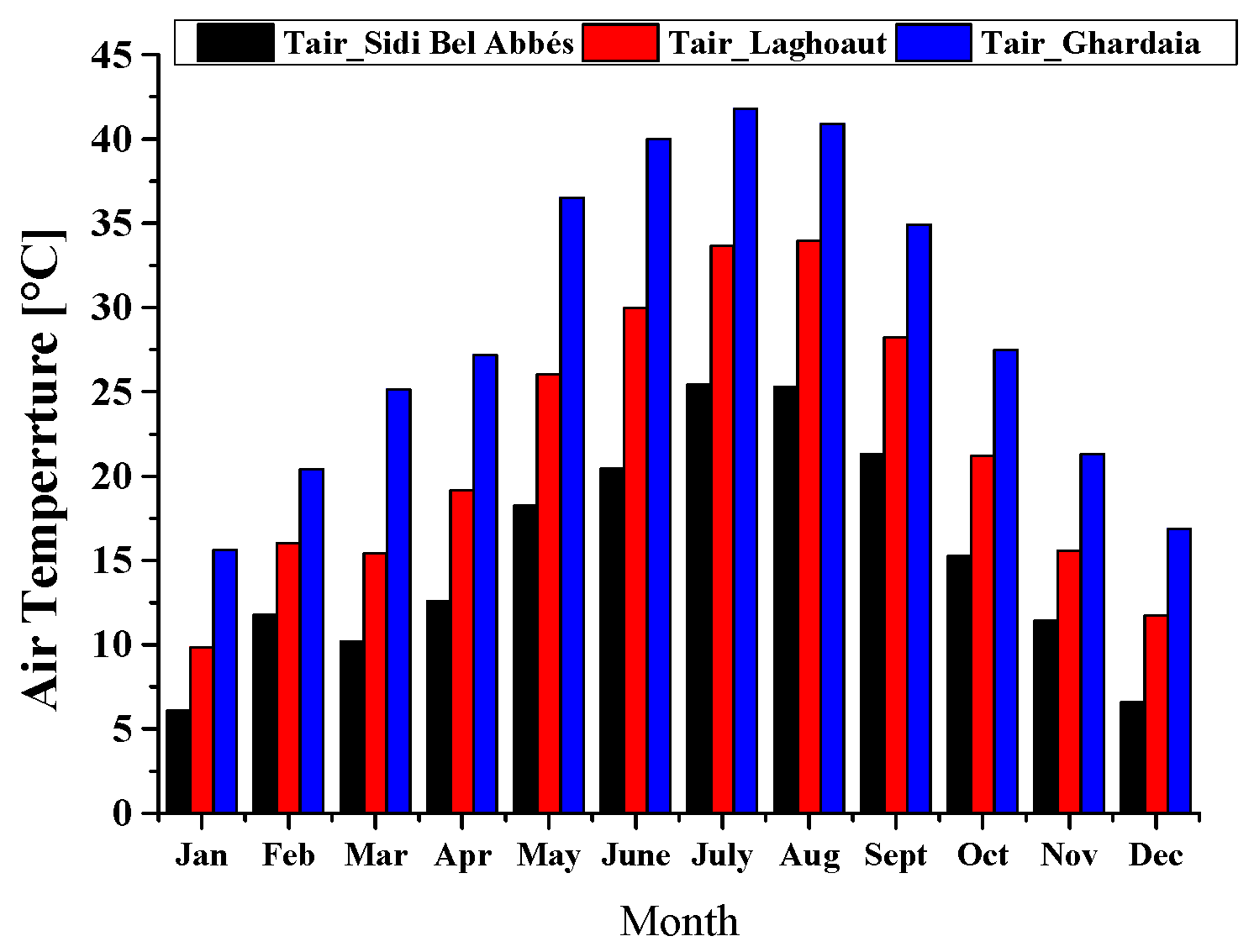
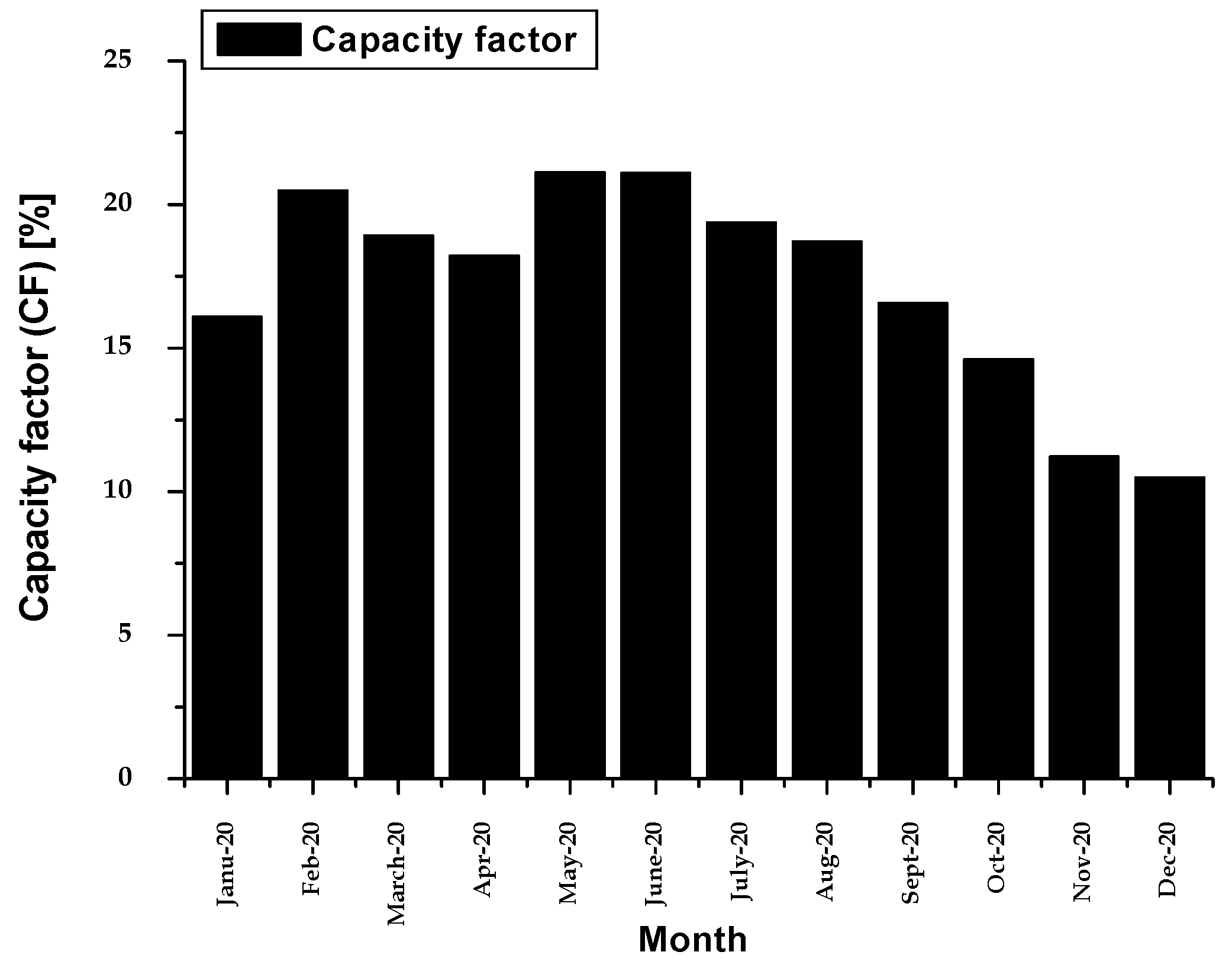
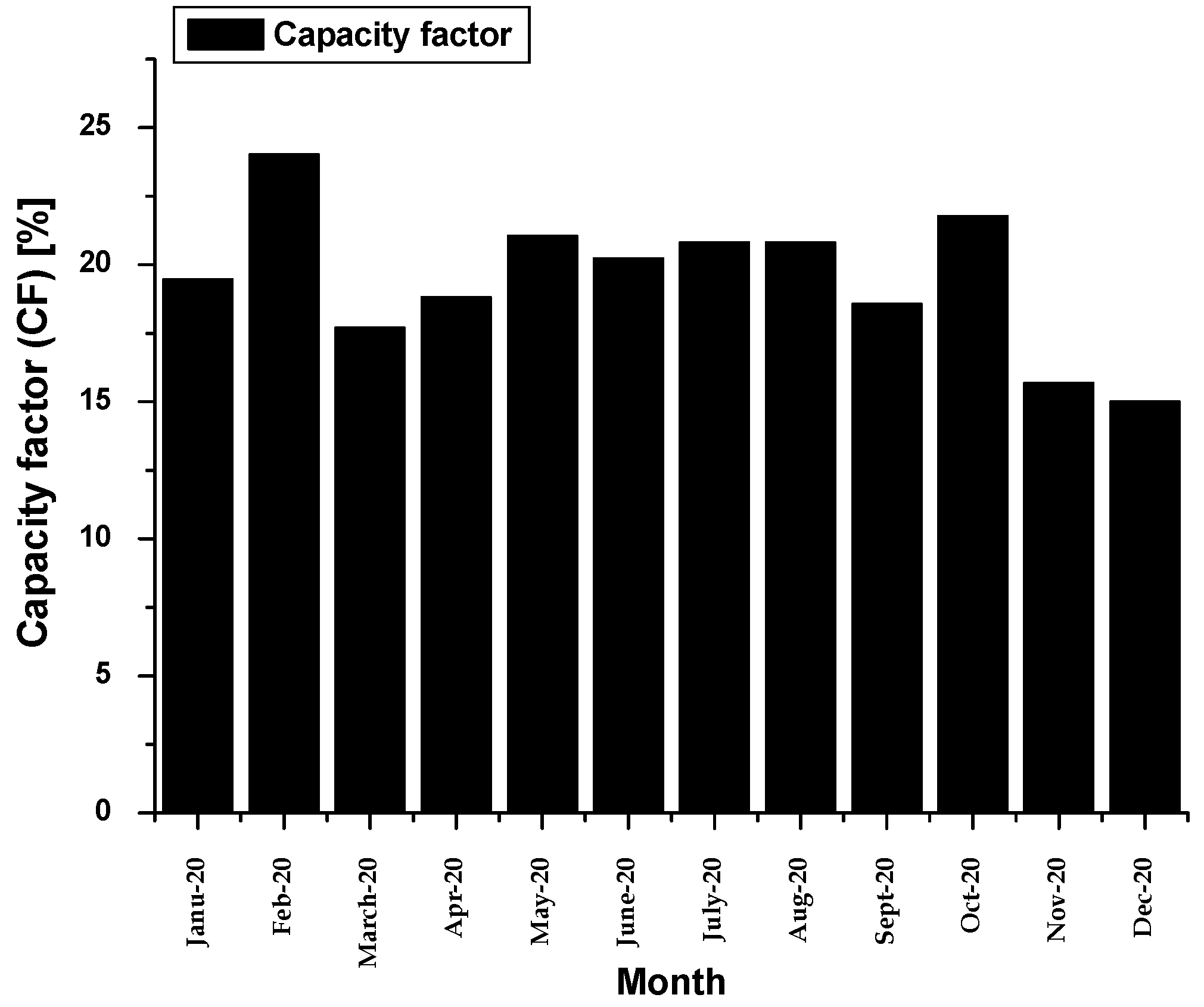
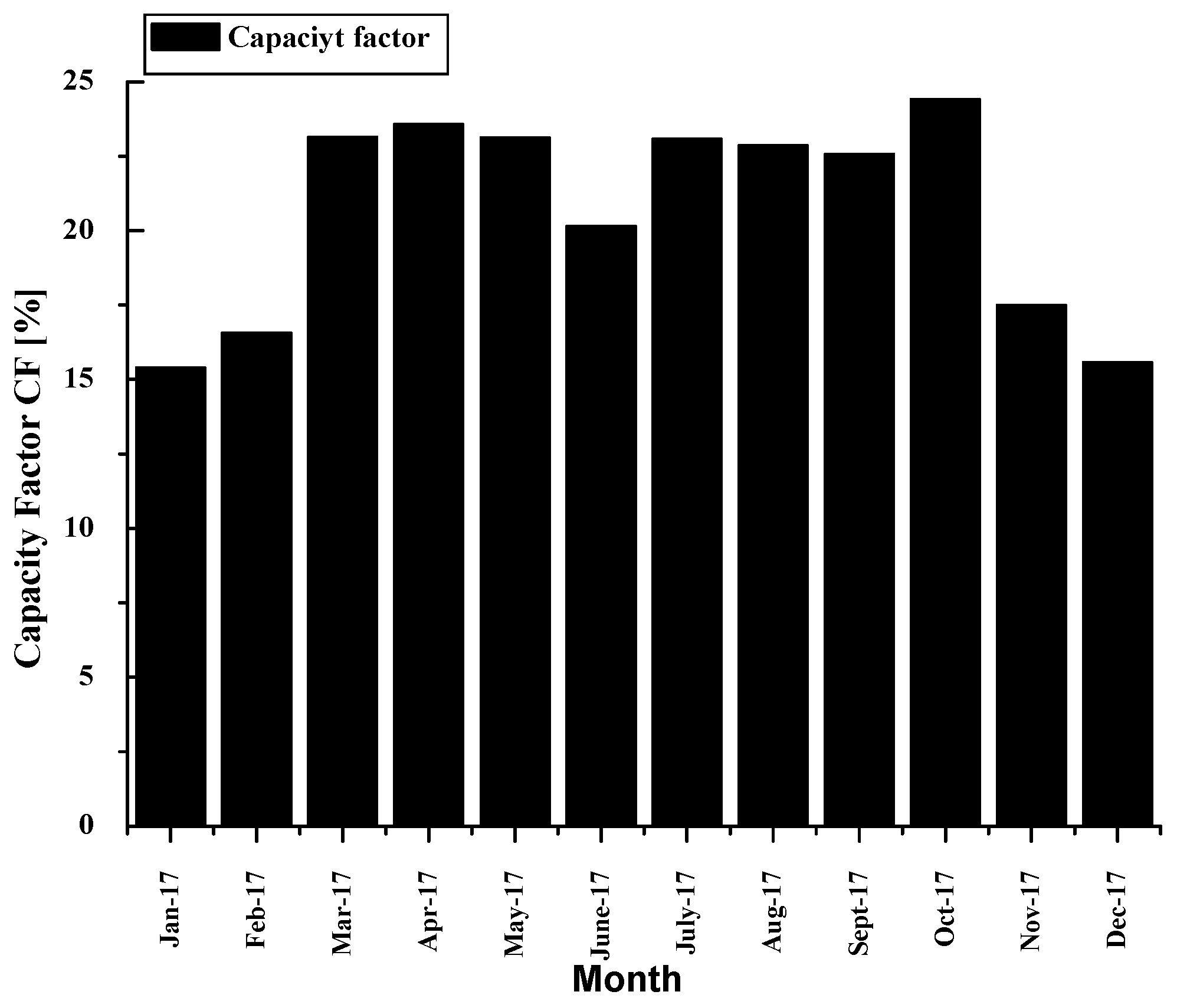

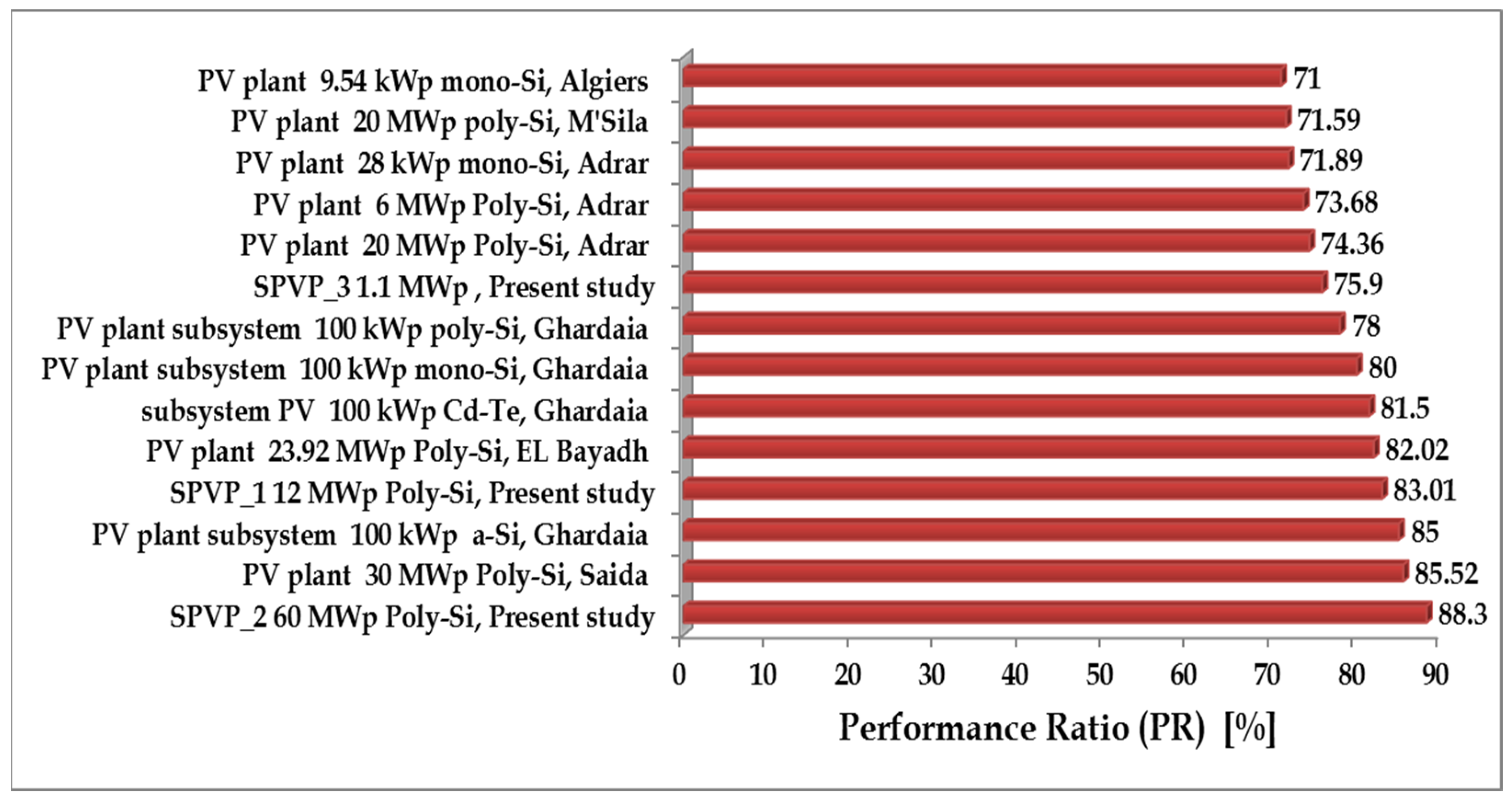
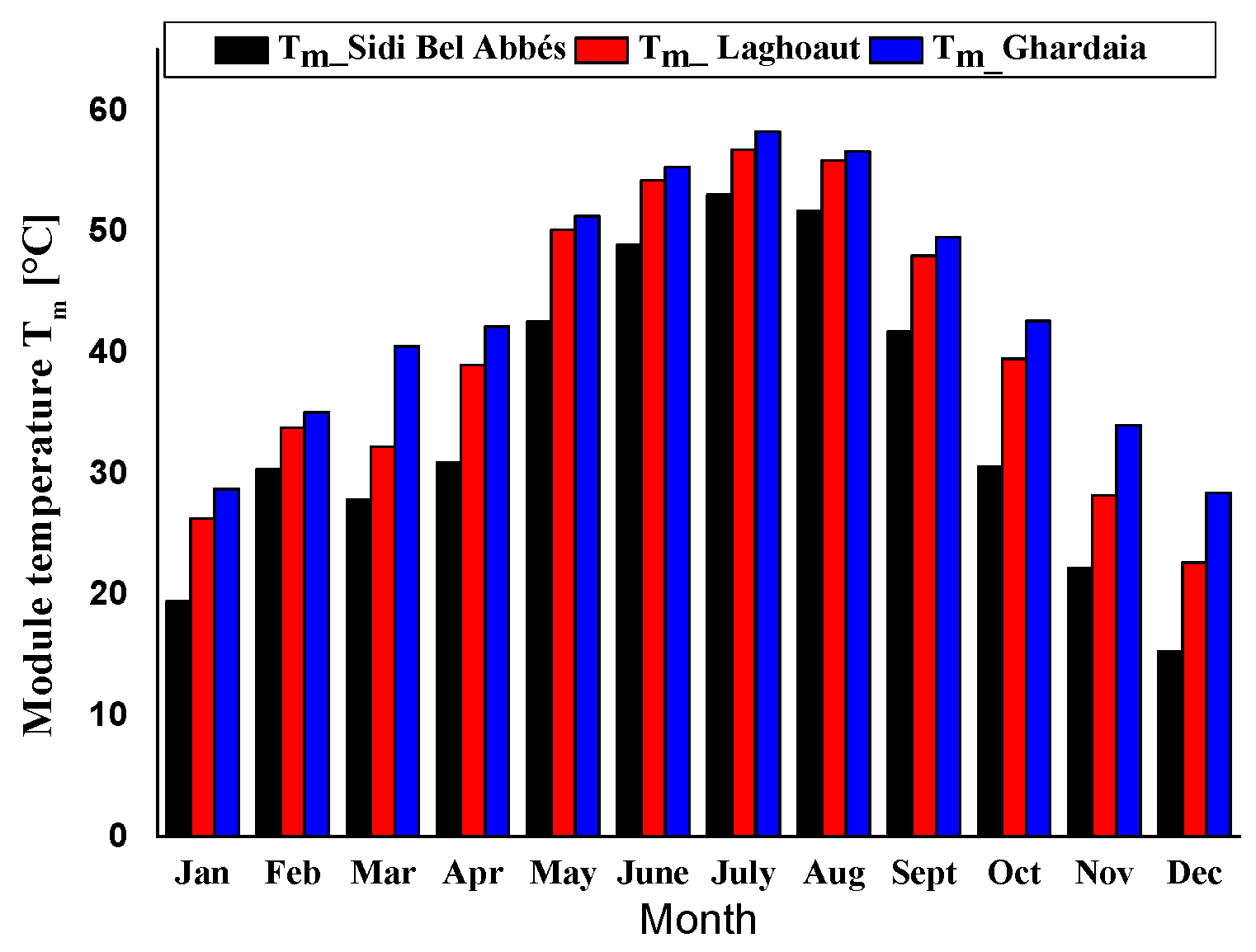



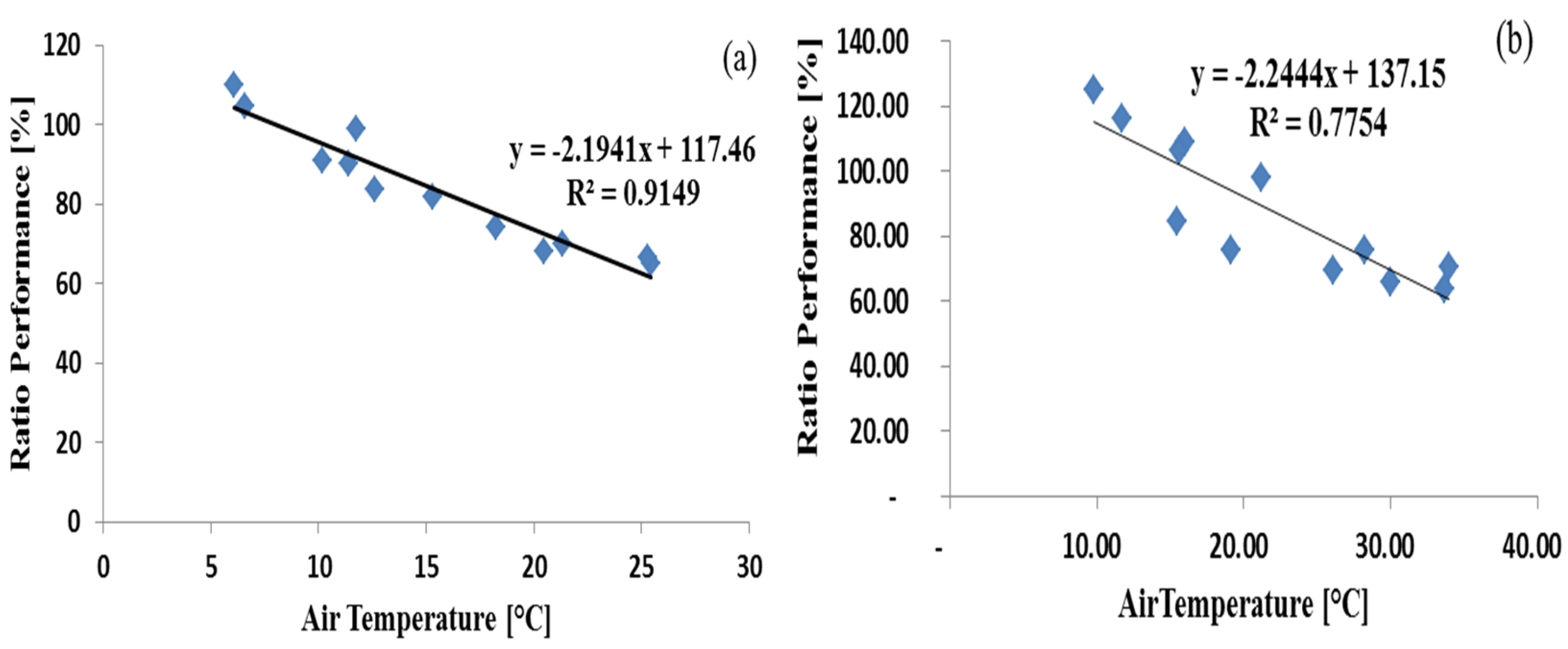
| PV Solar Fields | Sidi-bel-Abbés | Laghouat I and II | Ghardaïa |
|---|---|---|---|
| Latitude and longitude | 34°41′32.23″ N, 0°36′2.89″ O | 33°43′26.74″ N, 2°48′45.27″ E | 32°36′1.46″ N, 3°42′3.42″ E |
| Installed capacity | 12 MWp | 60 MWp | 1.1 MWp |
| Number of solar panels | 47,808 (×250 W, Poly-Si) | 240,000 (×250 W, Poly-Si) | 6089 (1880 × 250 W (mono-Si), 1960 × 235 W (poly-Si), 988 × 103 W (a-Si), 1261 × 80 W (Cd-Te)) |
| Number of inverters | 12 (×880 kVA) | 120 (×500 kW) | 8 (6 × 96 kW + 2 × 239 kW) |
| Area | 32.6 Ha | 120 Ha | 10 Ha |
| Location | Plants Capacity [kWp] | PV Type | Final Yield Yf [kWh/kWp/d] | PR [%] | CF [%] | References |
|---|---|---|---|---|---|---|
| Sidi-bel-Abbés, Algeria Laghoaut, Algeria Ghardaïa, Algeria | 12,000 | poly-Si | 4.15 | 83.01 | 17.20 | Present Study |
| 60,000 | poly-Si | 4.68 | 88.3 | 19.45 | ||
| 455.9 * | poly-Si | |||||
| 465 * | mono-Si | |||||
| 100.1168 ** | a-Si | 4.94 | 75.9 | 20.60 | ||
| 100.8 ** | Cd-Te | |||||
| Ghardaïa, Algeria | 100 | poly-Si | 4.54 | 78 | 19.03 | [29] |
| 100 | mono-Si | 4.85 | 80 | 20.51 | ||
| 100 | a-Si | 5.29 | 85 | 22.11 | ||
| 100 | Cd-Te | 4.98 | 81.50 | 21.22 | ||
| M’Sila, Algeria | 20,000 | poly-Si | 3.99–5.897 | 71.59 | 21.16 | [23] |
| Adrar, Algeria | 28 | mono-Si | 4.4 | 71.89 | 18.58 | [26] |
| Adrar, Algeria | 6000 | poly-Si | 5.15 | 73.68 | 20.32–23.4 | [27] |
| Adrar, Algeria | 20,000 | poly-Si | 4.98 | 74.36 | 20.81 | [28] |
| Bouzareah, Algeria (rooftop PV) | 9.54 | mono-Si | 2.15–4.30 | 71 | -- | [22] |
| Saida, Algeria | 30,000 | poly-Si | 4.9 | 85.52 | -- | [24] |
| El Bayadh, Algeria | 23,920 | poly-Si | 4.95 | 82.02 | 20.64 | [25] |
| Nouakchoutt, Mauritania (rooftop PV) | 48 | poly-Si | 4.56 | 77.75 | 19 | [15] |
| Tangier, Morocco (rooftop PV) | 5 | poly-Si | 4.45 | 79 | 14.84 | [16] |
| Sohar, Oman | 1.4 | poly-Si | 5.14 | 84.6 | 21 | [17] |
| Abu Dhabi, UAE (rooftop PV) | 114.4 | poly-Si | 4.16 | 80 | 17.37 | [18] |
| 50.4 | poly-Si | 4.93 | 81 | 20.57 | ||
| 215.7 | mono-Si | 3.63 | 70 | 15.13 | ||
| 994 | mono-Si | 3.94 | -- | 16.40 | ||
| Turkey | 2130.7 | poly-Si | 4.53 | 81.15 | 18.86 | [19] |
| Crete, Greece | 171.1 | poly-Si | 3.66 | 67.40 | 15.30 | [21] |
| Malaysia (rooftop PV) | 232.50 | mono-Si | -- | 85.40 | 14.85 | [39] |
Disclaimer/Publisher’s Note: The statements, opinions and data contained in all publications are solely those of the individual author(s) and contributor(s) and not of MDPI and/or the editor(s). MDPI and/or the editor(s) disclaim responsibility for any injury to people or property resulting from any ideas, methods, instructions or products referred to in the content. |
© 2023 by the authors. Licensee MDPI, Basel, Switzerland. This article is an open access article distributed under the terms and conditions of the Creative Commons Attribution (CC BY) license (https://creativecommons.org/licenses/by/4.0/).
Share and Cite
Fezzani, A.; Guermoui, M.; Kouzou, A.; Hafaifa, A.; Zaghba, L.; Drid, S.; Rodriguez, J.; Abdelrahem, M. Performances Analysis of Three Grid-Tied Large-Scale Solar PV Plants in Varied Climatic Conditions: A Case Study in Algeria. Sustainability 2023, 15, 14282. https://doi.org/10.3390/su151914282
Fezzani A, Guermoui M, Kouzou A, Hafaifa A, Zaghba L, Drid S, Rodriguez J, Abdelrahem M. Performances Analysis of Three Grid-Tied Large-Scale Solar PV Plants in Varied Climatic Conditions: A Case Study in Algeria. Sustainability. 2023; 15(19):14282. https://doi.org/10.3390/su151914282
Chicago/Turabian StyleFezzani, Amor, Mawloud Guermoui, Abdellah Kouzou, Ahmed Hafaifa, Layachi Zaghba, Said Drid, Jose Rodriguez, and Mohamed Abdelrahem. 2023. "Performances Analysis of Three Grid-Tied Large-Scale Solar PV Plants in Varied Climatic Conditions: A Case Study in Algeria" Sustainability 15, no. 19: 14282. https://doi.org/10.3390/su151914282







